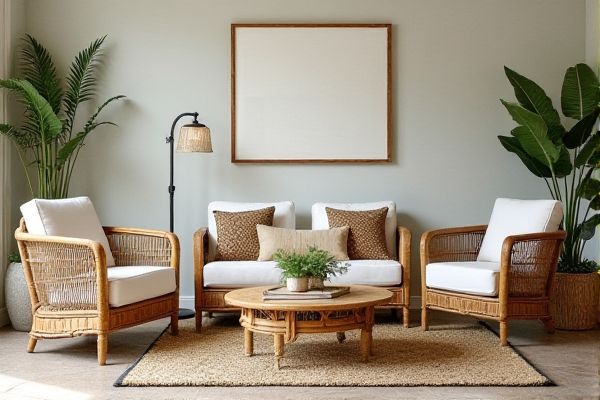
Resin wicker furniture offers superior durability and weather resistance compared to bamboo, making it ideal for outdoor use and requiring less maintenance. To discover which material best suits your lifestyle and aesthetic preferences, continue reading the rest of the article.
Table of Comparison
| Feature | Resin Wicker Furniture | Bamboo Furniture |
|---|---|---|
| Material | Synthetic resin woven over aluminum frame | Natural bamboo stalks and slats |
| Durability | Highly durable; weather-resistant and UV-proof | Moderately durable; prone to cracking and moisture damage |
| Maintenance | Low maintenance; easy to clean with soap and water | Requires regular sealing and protection from humidity |
| Weight | Lightweight due to aluminum frame | Heavier; depends on bamboo thickness |
| Appearance | Modern, uniform look; available in various colors | Natural, rustic look with natural variations |
| Eco-Friendliness | Less eco-friendly; synthetic materials involved | Highly eco-friendly; renewable and biodegradable |
| Cost | Moderate to high | Generally more affordable |
| Typical Usage | Outdoor patios, gardens, poolside areas | Indoor furniture, covered patios, casual settings |
Introduction to Resin Wicker and Bamboo Furniture
Resin wicker furniture features synthetic fibers woven over a sturdy frame, offering exceptional durability, weather resistance, and low maintenance ideal for outdoor use. Bamboo furniture, crafted from natural bamboo stalks, provides an eco-friendly, lightweight, and visually appealing option known for its strength and sustainability. Your choice between resin wicker and bamboo will depend on durability needs, environmental impact, and style preferences.
Material Composition and Durability
Resin wicker furniture is made from synthetic polyethylene fibers designed to withstand UV rays, moisture, and temperature fluctuations, making it highly durable and low-maintenance. Bamboo furniture consists of natural bamboo stalks that offer eco-friendly appeal and lightweight strength but require protective treatments to resist weather damage and insect infestations. The synthetic composition of resin wicker provides superior longevity compared to the organic nature of bamboo, which is more prone to wear in outdoor environments.
Weather Resistance Comparison
Resin wicker furniture offers superior weather resistance compared to bamboo, as it is made from synthetic materials designed to withstand moisture, UV rays, and temperature fluctuations without warping or fading. Bamboo furniture, while eco-friendly and aesthetically pleasing, may degrade faster when exposed to prolonged moisture and sunlight, requiring regular maintenance and protective treatments. Choosing resin wicker ensures your outdoor setup remains durable and visually appealing through various weather conditions.
Maintenance and Cleaning Needs
Resin wicker furniture requires minimal maintenance, needing only periodic cleaning with a mild soap solution to remove dirt and debris while resisting moisture and UV damage. Bamboo furniture demands more frequent care, including regular dusting, occasional polishing, and protection from excessive moisture to prevent mold and cracking. Both materials benefit from avoiding harsh chemicals, but resin wicker is generally more durable and easier to maintain in outdoor environments.
Design Versatility and Aesthetic Appeal
Resin wicker furniture offers exceptional design versatility with a wide range of colors, textures, and weather-resistant finishes, making it ideal for modern and traditional outdoor spaces. Bamboo furniture provides a natural, eco-friendly aesthetic with unique grain patterns and a warm, tropical charm that enhances any indoor or outdoor setting. Your choice depends on whether you prefer the sleek, customizable look of resin wicker or the organic, sustainable beauty of bamboo.
Comfort and Ergonomics
Resin wicker furniture offers superior comfort and ergonomics due to its flexible synthetic weave that adapts to body contours, providing excellent support and cushioning when paired with plush cushions. Bamboo furniture, while sturdy and eco-friendly, tends to have a firmer surface and less give, which may require additional padding to achieve similar comfort levels. The lightweight nature of resin wicker also allows for more ergonomic designs that promote better posture and ease of movement.
Environmental Impact and Sustainability
Resin wicker furniture is made from synthetic materials like polyethylene, which are durable but rely on petroleum-based resources, making their production less sustainable and less biodegradable compared to bamboo. Bamboo furniture is highly renewable, growing rapidly without the need for pesticides, and it sequesters carbon dioxide, contributing positively to the environment. Despite its shorter lifespan, bamboo's natural biodegradability and lower carbon footprint make it a more eco-friendly choice than resin wicker.
Cost and Affordability
Resin wicker furniture generally offers greater affordability with prices ranging from $200 to $1,000 depending on size and brand, making it accessible for budget-conscious buyers. Bamboo furniture tends to be more expensive, often costing between $300 and $1,500 due to the sustainable harvesting process and craftsmanship involved. Consumers seeking cost-effective outdoor furniture frequently opt for resin wicker because of its durability and lower price point compared to premium bamboo options.
Ideal Uses: Indoor vs Outdoor
Resin wicker furniture is ideal for outdoor use due to its high resistance to moisture, UV rays, and temperature fluctuations, making it perfect for patios, gardens, and poolside areas. Bamboo furniture, while lightweight and aesthetically pleasing, is better suited for indoor environments or covered outdoor spaces because it is prone to damage from prolonged exposure to moisture and sunlight. Choosing resin wicker for outdoor durability and bamboo for stylish, indoor comfort maximizes longevity and functionality in each setting.
Choosing the Best Option for Your Space
Resin wicker furniture offers durability, weather resistance, and low maintenance, making it ideal for outdoor spaces exposed to varying climates. Bamboo furniture provides a natural, eco-friendly aesthetic but requires more care and protection from moisture and pests to maintain its longevity. Consider your space's exposure to elements and your maintenance preferences when choosing the best option for your outdoor or indoor setting.
 homyna.com
homyna.com